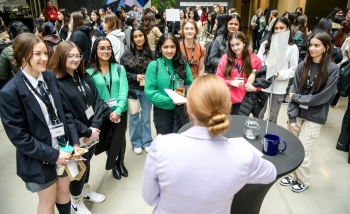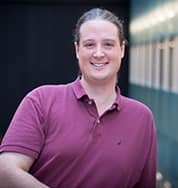2016 is a landmark year for science fiction: the original Star Trek is turning 50! Now that we are living in the future, among physicists who have been inspired by the Trek vision, we get to ask them: is Star Trek possible?
Are transporters possible?
Astrophysicist Avery Broderick[/caption]
Avery Broderick: Why wouldn’t transporters be possible? We can already use quantum mechanics to teleport things as big as molecules. There’s a lot of scaling up to do between a molecule and a person, but as physicists like to say, that’s an engineering problem. The biggest challenge is probably not the actual transporter, but the information processing required to keep track of that many quantum particles. Also, you have to destroy the original to create the duplicate, so I’m not sure I’d sign up for the test run.
Avery Broderick is an Associate Faculty member at Perimeter Institute and the University of Waterloo. He says he became a physicist “because Star Fleet doesn’t exist.” He’s an astrophysicist with a particular interest in black holes.
Is warp drive possible?
Adrienne Erickcek: The “warp drive” is aptly named: the most probable way to travel faster than the speed of light is to warp spacetime. Einstein’s theory of special relativity states that nothing can go faster than the speed of light, but his theory of general relativity permits a loophole: it may be possible to contract space in front of a ship and expand space behind it in such a way that the ship could reach its destination at faster-than-light speeds. Unfortunately, warping space in this way would require a tremendous amount of energy, and the resulting distortion of spacetime would likely destroy everything at the ship’s destination. That’s not the friendliest way to make first contact!
Adrienne Erickcek is an Assistant Professor at the University of North Carolina at Chapel Hill and was a postdoctoral researcher at Perimeter from 2009 to 2013. She’s a theoretical cosmologist whose research focuses on dark matter, dark energy, and the universe’s first second.
Are tractor beams possible?
Perimeter science writer Stephanie Keating[/caption]
Stephanie Keating: Not only are tractor beams possible, they actually already exist – at least, in a limited sense. Two years ago, physicists created a tractor beam that uses a hollow laser, which is dark in the centre and bright around the edges. The laser heats up particles, which become trapped in the centre of the beam. This kind of tractor beam can move very tiny particles distances up to a few metres. Last year, scientists created another sort of tractor beam: a sonic one that uses sound waves timed in a very precise way. This creates a pocket of low pressure, allowing you to trap objects and move them around through the air. Now, we’re not quite trapping spaceships yet. These were just “proof of concept” experiments, done on fairly small scales. But larger versions could one day be created for shifting bigger objects through 3D space. We could imagine practical purposes for these beams – like moving goods in warehouses, for example.
Stephanie Keating was an astronomer before she joined Perimeter Institute’s publications team as a science writer. If she had a tractor beam, she’d use it to swoosh her cat’s toys (but not her cat) around the house.
About PI
Perimeter Institute is the world’s largest research hub devoted to theoretical physics. The independent Institute was founded in 1999 to foster breakthroughs in the fundamental understanding of our universe, from the smallest particles to the entire cosmos. Research at Perimeter is motivated by the understanding that fundamental science advances human knowledge and catalyzes innovation, and that today’s theoretical physics is tomorrow’s technology. Located in the Region of Waterloo, the not-for-profit Institute is a unique public-private endeavour, including the Governments of Ontario and Canada, that enables cutting-edge research, trains the next generation of scientific pioneers, and shares the power of physics through award-winning educational outreach and public engagement.
You might be interested in




